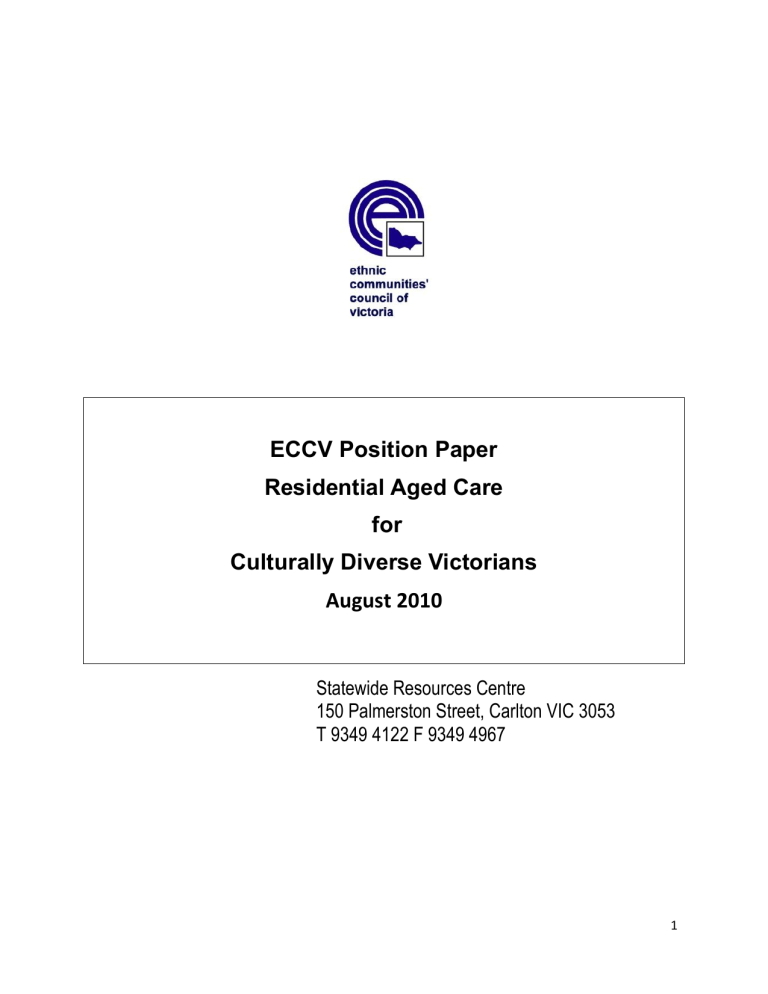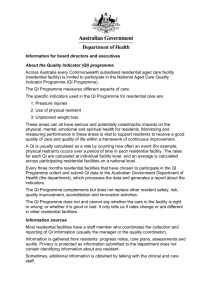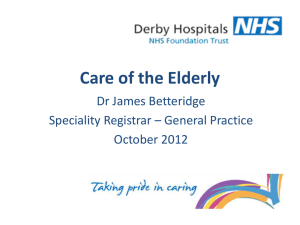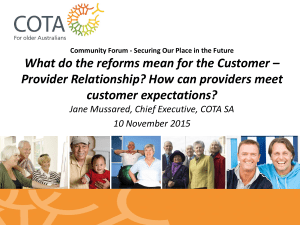ECCV Position Paper Residential Aged Care for Culturally Diverse

ECCV Position Paper
Residential Aged Care
for
Culturally Diverse Victorians
August 2010
Statewide Resources Centre
150 Palmerston Street, Carlton VIC 3053
T 9349 4122 F 9349 4967
1
Residential aged care facilities in Victoria and Australia can expect to see an increase in the cultural diversity of residents in the next two decades. The average age for entering residential care in Australia is 82; and about a third of all older men and half of older women will enter a residential care facility (UNSW 2010). By 2026 one in every four people aged over 80 will be from a culturally diverse and non-English speaking background (Gibson AIHW 2001).
There are three types of residential aged care facilities in Australia:
Mainstream nursing homes are the majority
Some facilities have voluntary clusters of language-specific groups that accommodate multicultural needs
Under 10% are ethno-specific nursing homes with long admission waiting lists
In 2008, there were approximately 800 residential aged care services in Victoria caring for about 50,000 seniors according to the Victorian Government Residential Aged Care
Policy 2009 . Population trends show that in Melbourne, by 2011, 40% of people over 65 will be from culturally and linguistically diverse backgrounds.
Research (Deakin University 2010) indicates that respect and cultural contact are key factors in determining the quality of life of older people. Older people prefer to live in a facility which caters to their own cultural background. Access to ethno-specific residential aged care facilities is limited and even more so for newly arrived, geographically dispersed and smaller ethnic groups (UNSW 2009).
Capital funding
ECCV advocates for more capital support by the Commonwealth to assist ethnic communities wishing to secure land and establish ethno-specific residential aged care facilities. ECCV would like to see more government grants and loans to enable new ethno-specific providers to move into the residential care sector. This would benefit emerging ageing culturally diverse communities. In Victoria preference should be given to growth on the periphery of the metropolitan city where greenbelt sites are likely to be available and in regional centres that have limited aged care services. In addition ECCV advocates for the Aged Care Land Bank initiative to give preference to ethnic communities in the inner city areas of metropolitan Melbourne to establish residential aged care facilities.
ECCV is aware that the numbers of older people in various ethnic communities form a mosaic of ageing cohorts based on their immigration vintage (Howe 2006). In the event that ethno-specific aged care facilities are faced with declining populations, they would
2
be well-placed, as cultural competency specialists, to cater for varying multicultural clusters of language-specific groups.
Culturally responsive care
Being a non-English speaking resident in a mainstream age care facility can be an isolating and lonely experience and many facilities provide inadequate culturally responsive care (UNSW 2009; Runci 2005).
The Aged Care Act 1997 forms the overall legislative framework for residential age care and the Residential Aged Care and Accreditation Standards ensure equitable access to culturally appropriate care. Stringent compliance with four accreditation standards and their related 44 expected outcomes is compulsory. One of those expected outcomes specifies a cultural competency Key Performance Indicator to ensure that the:
“cultural and spiritual life [in relation to] individual interests, customs, beliefs and cultural and ethnic backgrounds are valued and fostered.”
In order to further embed culturally responsive care, ECCV advocates that a regulated diversity framework be incorporated into the overall operations of residential aged care facilities to effectively meet the specific cultural, linguistic and spiritual needs ethnic clients.
Community awareness
ECCV acknowledges the good work undertaken by the Partners in Culturally
Appropriate Aged Care (PICAC) programs in sensitising Commonwealth funded residential aged care facilities to the needs of culturally diverse residents. ECCV also acknowledges the important work done by ethnic and multicultural organisations receiving Community Partners Program (CPP) funding to foster greater communication between ethnic communities and residential aged care service providers and improve ethnic communities‟ awareness and knowledge of aged care services.
ECCV would like to see an expansion of these programs to assist ethnic seniors practice informed choices of nursing homes and to improve culturally responsive care.
Community links
The Victorian Government Residential Aged Care Policy 2009 states that ideally residential facilities are closely connected and integrated into the community social structure which provides a range of supports to ensure the wellbeing of older people from all backgrounds.
ECCV consultation indicates that when ethnic groups make contact with mainstream aged care facilities to provide same-language friendly visiting programs and culturally appropriate meals for isolated non-English speaking residents, some nursing home staff
3
does not allocate time to foster such relationships. ECCV would like to see residential care facilities resourced to:
promote and support positive partnerships with ethnic and multicultural organisations;
facilitate active care relations between ethnic residents, their families and carers in the community.
Transition
Some new residents in facilities were attending ethno-specific social support Planned
Activity Groups (PAGs) in the community and they should be permitted to continue attending those PAGs for a transition period as it would be inhuman to withdraw their trusted social networks.
Language services
The report Strategic Directions in CALD Research in Australia (Runci et al 2005 in
UNSW 2009) indicates that non-English speaking residents often do not have access to staff members who can speak their language. A Monash University survey (Runci 2005) of 186 facilities in the south-eastern region of Melbourne indicated that 86% of aged care facilities had at least one resident who either „preferred‟ or „needed‟ to speak a non-English language.
ECCV advocates for free interpreter services for residents in aged care facilities.
Furthermore ECCV believes the Conditional Adjustment Payment (CAP) for improved management practices in ethno-specific residential facilities is under-funded. ECCV would like to see the CAP increased to include an allocation for the utilisation of languages services and culturally responsive care.
Dementia and funding instrument
Addressing the dementia epidemic in conjunction with culturally diverse care needs, is one of the greatest challenges of aged care facilities in the 21st century. English language deterioration is common amongst non-English speaking seniors of advanced age and with the onset of dementia. ECCV would like to see the Aged Care Funding
Instrument (ACFI) schedule in residential care, better reflect the additional language support required for non-English speaking residents.
Global trends in residential care indicate that smaller dementia-specific residential care facilities improve the resident‟s quality of life. ECCV advocates for multicultural clusters of similar cultural and language groups in smaller dementia units.
Evidence-based research
ECCV would like to see government investment into evidence-based research of best practice models of culturally responsive care delivery in ethno-specific residential care.
4
Advanced care planning
End of life issues can be challenging for families and carers of culturally diverse residents. Palliative care practices and options are not well understood in ethnic communities. ECCV advocates for translated information about advanced care planning and the concept of palliative care targeted at ethnic communities to improve their informed decision making regarding the health and wellbeing of residents in care facilities.
Bilingual workforce
In a climate where future workforce shortages are predicted by the 2010
Intergenerational Report, ECCV advocates for strategies and promotions to improve the recruitment, training and retention of bilingual staff in residential care facilities.
Some culturally diverse Overseas Qualified Nurses and care staff experience communication difficulties with colleagues, patients, residents and family members.
ECCV would like to see culturally responsive induction and orientation programs offered by residential facilities to new overseas-born staff as well as cultural briefings for local workers to improve their workforce transition into the Australian aged care system.
In addition ECCV would like to see incentives for bilingual GPs to access nursing homes through the Department of Health 2010 Aged Care Access Initiative.
References
Australian Government, Report on Strategic Directions in CALD Dementia Research in Australia - CALD (Culturally and
Linguistically Diverse groups) March 2009, Dementia Collaborative Research Centres and University of NSW, Sydney
Deakin University Australia 2010, “Respect in an Ageing Society: a research paper by Benetas and Deakin University”, May 2010
Gibson, D., Braun P., Benham, C. & Mason, F., 2001, Projections of Older Immigrants: people from culturally and linguistically diverse backgrounds, 1996-2026,
Australia AIHW cat. no. AGE 18; p 283
Howe, Anna L., 2006, Cultural Diversity, ageing and HACC: trends in Victoria in the next 15 years; a Project commissioned by Aged Care Branch, Department of
Human Services, Victoria
Language in Aged Residential Care presented at Cultural Diversity in Aged Care Conference, Melbourne. 2005 by Dr Susannah
Runci, A/Prof Jenny Redman & Prof Daniel O‟Connor, Aged Mental Health Research Unit Monash University accessed 10 August
2010 at http://www.culturaldiversity.com.au/Portals/0/Susannah_Runci_presentation.ppt
Runci, Sus annah J‟ O‟Connor, Daniel W , Redman, Jennifer R. 2005 Language needs and service provision for older persons from culturally and linguistically diverse backgrounds in south-east Melbourne residential care facilities Australasian Journal on Ageing
Volume 24, Issue 3, pages 157 –161, September
The Victorian Government‟s role in residential aged care Victorian Government residential aged care policy 2009
5







